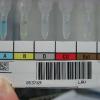Leaderboard
-
in all areas
- All areas
- Records
- Record Comments
- Record Reviews
- Jobs
- Jobs Comments
- Jobs Reviews
- Questions
- Question Comments
- Question Reviews
- Links
- Links Comments
- Files
- File Comments
- File Reviews
- Images
- Image Comments
- Albums
- Album Comments
- Records
- Record Comments
- Events
- Event Comments
- Blog Entries
- Blog Comments
- Topics
- Posts
- Status Updates
- Status Replies
-
Custom Date
-
All time
June 28 2007 - April 26 2024
-
Year
April 26 2023 - April 26 2024
-
Month
March 26 2024 - April 26 2024
-
Week
April 19 2024 - April 26 2024
-
Today
April 26 2024
-
Custom Date
06/07/2019 - 06/07/2019
-
All time
Popular Content
Showing content with the highest reputation on 06/07/2019 in all areas
-

Red Cell Storage Position
Malcolm Needs and 4 others reacted to ANORRIS for a topic
It is also easier to take inventory when they are standing up. If they are flat you would have to pick them up to count????5 points -
It is important to remember that inspectors are human and as John says, they can and do cite things because it's not how they do it. Don't take it personally. Their way may give you a good idea for improving your way. At the same time, don't be afraid to challenge a citation if you feel that you've met the intent of the standard and can prove it. I definitely don't recommend arguing with an FDA inspector - you are probably not going to win.4 points
-
Upright: so you can read the unit number plus the segments can be kept tidy to avoid getting tangled with each other, and observe hemolysis.2 points
-

Red Cell Storage Position
pstruik and one other reacted to Malcolm Needs for a topic
It is true that haemolysis can most easily be seen if the unit is stored in an upright position (note the phrase "most easily" - I am NOT saying that haemolysis cannot be seen if the unit is stored flat), however, more units can be stored in an upright position WITH the expiry date showing, than can be stored with them flat. If you have to move an upright unit to see an expiry date (or, in the UK, an Rh and K type - available on ALL units), you can easily do so without disturbing the red cell - plasma/SAGM interface, so that haemolysis is still easily seen, particularly as the units are usually in a cardboard box type thing to keep them upright. This is not so easy if the unit is stored flat and, in addition, it takes up more space in the average blood bank refrigerator, most of which are designed to take upright units.2 points -

Cell-Salvage Regulations
AMcCord and one other reacted to John C. Staley for a topic
The key here is they came to Linda and asked for help!2 points -
Hi Logan, I am an AABB perioperative assessor (and laboratory manager )that works at a facility in Boston MA that uses cell salvage on over 3,000 cases annually. We have 11 machines, and although we are not (yet) accredited by AABB, with the work we have done with our program, we are hoping to be accredited for periop by our next BB inspection. I got involved in this because our SVP for surgical services asked me, as the resident AABB SME, LOL, to evaluate effectiveness of cell salvage at our facility. She wanted us to adhere to the AABB standards and thought I was their best candidate to lead the effort. 6 years later, the past practice is truly history. To answer your question, we do QC quarterly on each machine that we have in use--- Hgb and Albumin. AABB allows you to decide what and how much is needed, but for quality purposes, you really do need something to make sure your equipment (and operator) is obtaining the best possible product for the patient in between PM's. If you would like more information on our approach, I am happy to share what we do, just message me and I will give you my work contact information. Between Cell Salvage and other specific PBM strategies, we have reduced our organization-wide transfusion ratio per adjusted patient discharge, from 0.78 to 0.17, in ~5 years time. ( Caveat: The cell salvage program overhaul took some time and was truly implemented last). I actually like to think it is because Blood Bank is involved, but honestly, it takes a village and I had to build influence up with the surgical services team and make really good use of my role as Transfusion Committee Facilitator to make things happen. Best, Linda2 points
-

Inspection Questions
TreeMoss and one other reacted to John C. Staley for a topic
What I quickly realized was that no 2 inspectors/assessors focus on the same thing. As David noted, they seemed to focus on things they were either cited for or had cited others for recently. Over the years I had been cited for something that had passed all previous inspections because the inspector simply did not like the way we did it. When I challenged the citation with the inspecting organization the citation was often over ruled, not always but often enough to make the challenge worth while. My best advice is to prepare the best you can and consider the inspections a learning experience and hope that David is your next inspector. On a side note I was a Blood Bank inspector for CAP for 30 years so I had ample experience on both sides. One last bit of advice, never ever argue with an FDA inspector!2 points -

Inspection Questions
AuntiS and one other reacted to David Saikin for a topic
You don't need to keep those records about irradiation. You are not performing it. As an inspector I almost always look at standards which I have been cited for. (I always disliked when the inspector said: "I knew I'd have to look really hard to find something in Dave's lab). That's not my style. I only dig if what I am finding merits such. I always look to verify you have corrected any prior deficiencies (these are given to us as part of the packet). I observe your staff and attempt to correlate what they are doing with what your policy/procedure says they should do. I also ask your staff (without a senior staff member accompanying me) about their work environment, employer, ability to attend CE programs. I want to see your quality stuff, especially any reports which you should have generated based on your QP. If you don't have anything it will be a long day for both of us. I will want to observe a transfusion or at least speak w a nurse about transfusions. Nursing training for transfusion and knowledge of reactions - this will be from Nursing Ed/Admin I don't want to review your procedure manual unless you ask me to look at specific items or you have added something new. I do want to see your table of contents so I can see what you do - I may take a peek at something there that piques my interest (I may also ask you if I might have a copy if it is something I'd like to bring to my own operation). There are lots of funny stories but you'll have to be inspected by me to hear them. (actually, most of them are quite sad as they involve citations). I tell your staff to relax because when I go back to work I do the same thing they do. I was an AABB inspector/assessor for 20+yrs. Still a CAP Team Leader.2 points -
Testing the same specimen twice may detect some internal testing errors, but will not detect WBIT (Wrong Blood In Tube). You need to gather some data to show how many patients would be impacted by collecting a second blood sample. Ask these questions, "How many patient admits annually?", "How many patient admits required blood bank testing?" (at my facility the calculated percentage was 11%), "How many patient samples type as Group O?" (at my facility the calculated percentage was 55% and we don't draw a second blood sample on these patients), "Of the non-Group O patients, how many had an independently collected blood sample in Hematology that could be used for the second ABO blood sample" (in our facility that was calculated to be 16%). So for every 1000 patients admitted annually, 100 (I'm using 10% for sake of simple calculations) would require blood bank testing of whom 45 (100-55) would be non-group O, 7 (45 x 0.16) would have a blood sample in hematology, leaving 38 (45 - 7) or 3.8% (38/1000) patients requiring a second sample to be collected. Using this kind of data will give you a much better grasp of the impact of routine performance of a second ABO determination on all patients for whom a Type and Screen or a Type and Crossmatch is ordered.1 point
-

Eluate
John C. Staley reacted to Malcolm Needs for a topic
No is the simple answer, however, NOTHING in blood transfusion/blood group serology is ever simple! I would thoroughly recommend you listen to the latest Podcast by BloodBankGuy (Dr Joe Chaffin) and Dr Stella Chou, which may shed light on the subject. It could well be that your patient has a Partial C (not unlike a Partial D, but not absolutely identical, as the E or e antigen is frequently also involved), particularly if your patient is of a Black ethnicity. One mutant Rh haplotype that is found not infrequently within the Black populations is (C)cdeS. With this , the C antigen is not detected by all anti-C reagents and so can appear to be C Negative. Such individuals also have a mutation causing a partial e antigen, and these people can produce an anti-hrB. Anti-hrB is relatively clinically insignificant (as opposed to anti-HrB, which is very definitely clinically significant), but mimics an anti-C+e, with the apparent anti-C element being considerably stronger than the apparent anti-e element. In addition, warm auto-antibodies classically mimic Rh specificities, and this could be such a case (the patient does not necessarily have to be diagnosed with WAIHA). While the auto-antibodies normally have a mimicking specificity within the Rh Blood Group System, this is not universal. I remember following a patient for years who was K Negative. He was never transfused with K Positive blood or blood components, and yet we were able to eluate what appeared to be an anti-K. This finding was confirmed by Joyce Poole at the International Blood Group Reference Laboratory, who was convinced that it was a mimicking specificity. I would be really grateful if you could keep us up-dated on your findings - purely because I am nosy!!!!!!!!!1 point -
Aside from the "yuck" factor, centrifuges for WB are huge and generate massive G forces, a regular centrifuge would never work. Just an option. Also, would your vendor take them back?1 point
-

Inspection Questions
applejw reacted to David Saikin for a topic
I agree with John. Challenge whenever you think you are in compliance. I always do - win about 60% of the time. Many inspectors can't see the forest for the trees. There are many ways to do things that comply. Just because the inspector disagrees does not always mean they are correct. I find this moreso with CAP than AABB but sometimes the latter exude hubris (doesn't mean you are wrong). Worse case scenario - you have to update something. AND NEVER ARGUE W THE FDA. I've seen those folks go to great lengths to find a needle in a haystack if you give them a hard time. I won't elaborate here but . . . take our word for it. Besides, they can take you out in handcuffs if they think you deserve it. (there is an enforcement arm). Good luck. You'll do fine.1 point -

Inspection Questions
TreeMoss reacted to David Saikin for a topic
One other thing I do is to have you select 5 components which have final disposition. Then see that every person that dealt with that component had a competency for what they did - including those who transfused.1 point -
to Abstract for the Leonard paper published in Transfusion Transfusion. 2019 Apr;59(4):1183-1189. doi: 10.1111/trf.15154. Epub 2019 Feb 5. Identification of red blood cell antibodies in maternal breast milk implicated in prolonged hemolytic disease of the fetus and newborn. Leonard A1, Hittson Boal L1, Pary P2, Mo YD2, Jacquot C2, Luban NL1,2, Darbari DS1, Webb J1,2. Author information Abstract BACKGROUND: Alloantibodies against more than 50 non-ABO blood group antigens have been implicated in hemolytic disease of the fetus and newborn (HDFN) and are expected to wane within weeks after delivery. Persistent anemia leads to the hypothesis of continued exposure to red blood cell (RBC) alloantibodies via breast milk, which has been shown in a murine model and suggested in rare case reports. CASE REPORT: We report three cases of prolonged HDFN in two neonates with anti-D HDFN and one with anti-Jka HDFN. Patient 1 demonstrated 4+ anti-D serologic testing beyond 2 months; therefore, antibody testing was performed on maternal breast milk. METHODS: Maternal serum samples were tested for the presence of unexpected antibodies using standard Ortho gel card and 37 °C 60 minutes with anti-human globulin (AHG) tube saline methods. Antibody titrations were performed using the standard 37 °C 60 minutes to AHG tube saline method. Fresh breast milk samples were tested using the standard 37 °C 60 minutes to AHG tube saline method for both unexpected antibodies and titration study. Fresh breast milk from an O-positive, antibody-negative donor was used as control for any reactivity that may have been due to milk solids or proteins alone. RESULTS: Using a known methodology applied in a novel way to test breast milk for RBC alloantibodies, antibodies against fetal RBCs were identified in the maternal breast milk of three patients. CONCLUSION: Maternal RBC alloantibodies are present in breast milk and may be clinically significant in patients with prolonged recovery from HDFN. © 2019 AABB.1 point
-
If at all possible, they would have to consult with our pathologist. Then beyond that, the physician in charge of the case would have to provide documentation that it is an emergent situation and that they are aware that they are transfusing incompatible product. Having said that, it seems like it would be a really bad idea. Giving A plasma to an unknown is one thing, but O plasma? Scott1 point



